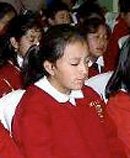
|
|
Do gender differences affect student achievement? In most developing countries, the education of girls lags far behind that of boys. Yet because educated girls are better able to care for their families, universal education for girls is considered a major way to lead developing countries out of poverty. Helping all girls and boys receive an education is the mission of UNGEI, the United Nations Girls’ Education Initiative. The good news is that in America, the education of girls is on the rise. In fact, some researchers think that it’s not the girls who now need help, it’s the boys. Since 2006, the gap is widening between boys’ and girls’ achievement. A recent NY Times article by David Leonhardt: “A Link Between Fidgety Boys and A Sputtering Economy” cites a paper by Diprete and Buchmann from Third Way, a Washington research group, which found getting As and Bs in middle school is a predictor for success in college. Girls significantly out-performed boys in academic grades (48% of the girls earned As and Bs while only 31% of the boys scored that high). Girls also out-performed boys in social behaviors that lead to success such as attentiveness, persistence, flexibility, independence, and “behaving.” When I scrolled through the 635 comments on this article, I was struck by how many parents and educators felt that boys need a different kind of education. One possible reason is the current emphasis on standardized testing. In an effort to raise test scores to comply with the No Child Left Behind Act of 2001, schools across the country have cancelled art, music, PE and even recess to allow more time for kids to focus on academics. This cerebral, non-kinesthetic approach does not serve any student, but it hits boys the hardest, because they mature at a slower pace and often find it harder to sit still for hours at a desk. Some experts point to gender-specific education as a key to help both boys and girls learn. While in the past girls-only educational settings have been found to benefit girls more than boys (especially in closing the gender gap in math and science achievement), it seems that boys may also thrive in all-boys classrooms that favor a more engaging, active learning style. One thing is clear: girls and boys alike are struggling with stress today, and stress can make it hard to focus. Some schools are helping their students experience academic success without stress by introducing the Transcendental Meditation technique. By meditating for a few minutes at the beginning and end of the school day, many children—along with their parents and teachers—are reporting a wide range of positive benefits due to their meditation sessions, from better grades to better behavior to feeling happier. Even kids with ADHD—which affects more boys than girls—can be helped by meditating. Here are some comments from kids with ADHD: “TM helped me with my schoolwork, I’m not getting as frustrated with friends, doing my homework better, not getting in as many fights at school, stuff like that.” “It’s easier to focus and work on one thing instead of fidgeting. It makes me more confident.” “I’m more calm, less hyper and more mature than I was before. Now all my friends want me to come over to their house.” And the research backs up these positive reports. A random-assignment controlled study published in 2012 in Mind & Brain, The Journal of Psychiatry (Vol 2, No 1) found improved brain functioning and decreased symptoms of ADHD in students practicing the Transcendental Meditation technique. The paper, ADHD, Brain Functioning, and Transcendental Meditation Practice, is the second published study demonstrating TM's ability to help students with attention-related difficulties. “The Transcendental Meditation technique increases blood flow to the brain,” says Dr. Sarina Grosswald, the principal investigator of the study. “That’s important because one of the physiological correlates of ADHD is reduced blood flow in the brain. Practice of the TM technique also results in a dramatic reduction in stress, anxiety, and depression.” Dr. Grosswald’s study also found that organization, memory and strategizing skills significantly improved. If boys and girls alike increased their learning ability and academic achievement by practicing the TM technique twice a day, perhaps there really could be a time when no child—or gender fell behind. In fact, perhaps all students' progress would leap ahead. ----------------------------- About the author: Linda Egenes writes about green and healthy living and is the author of six books, including Super Healthy Kids: A Parent’s Guide to Maharishi Ayurveda, co-authored with Kumuda Reddy, M.D.
© Copyright 2014 Global Mother Divine Organization
|
|

